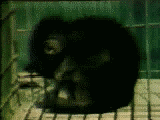 | 
|
| Institutionalized child rocking his head and body |
Isolation-reared monkey rocking its head and body |
 | 
|
| Institutionalized child rocking his head and body |
Isolation-reared monkey rocking its head and body |
The complete documentary is available online with permission. You can view it using Real Player 7 which is available for Windows and for MacOS users.
There are two versions of the 30-minutes video available:
| 56 K modem version (34 kbps) | play – download (7.26 MB) |
| Dual ISDN version (80 kbps) | play – download (16.9 MB) |
Thanks to Glenn Shoemaker of Southbay Productions (Videotape and Multimedia Production) in Chula Vista / California, USA for digitizing the video!
The Time Life documentary "Rock A Bye Baby" describes the influence of different practices in infant treatment and child rearing on emotional development, both in humans and in monkeys.
In the beginning, it is noted that the contact of the child to the mother represents the first socio-emotional interaction the child experiences and lays the fundamentals for its later behaviors. We learn that social animals isolated from their mothers and receiving no nurturing physical affection develop severe depression and can die from such deprivation. In addition, maternal-infant isolation that leads to sensory deprivation can cause developmental brain damage. These facts show that mother love has a neurobiological basis that is essential for life.
Next we are introduced to Harry Harlow's experiments with surrogate mothers which have shown that monkeys raised alone in an environment without mother and peers prefer to be with a cloth-covered mother surrogate without a milk bottle rather than with a wire-cage surrogate mother that provides a milk bottle, even when hungry.
They even cling to their cloth-covered wooden dolls when they are frightened and they experience the same emotional stress other social animals experience when isolated from their surrogate mothers. These experiments show that the need for a loving relationship (percepted, in this case, by the "fur") is stronger than the mere need for food even when hungry. Thus, love-hunger is stronger than food-hunger.
Harlow's experiments are part of most psychology textbooks of today.
The single greatest contribution to understanding the mother-infant separation syndrome was provided by Drs. William Mason and Gershon Berkson in their swinging mother surrogate experiments where the importance of body movement (vestibular-cerebellar simulation) in mother-infant bonding was documented. Monkeys raised singly in cages in a colony room with stationary cloth mother surrogates were compared to those raised with swinging cloth mother surrogates. The infant monkeys reared on the stationary mother surrogate developed all of the abnormalities which isolation-reared monkeys develop – depression, social withdrawal, aversion to touch, stereotypical rocking and chronic toe and penis sucking, self-mutilation and pathological violence as juveniles and adults.
The infant monkeys reared on the swinging surrogate mother developed normally with only minor stimulus-seeking behaviors, e.g. thumb-sucking. Depression, social withdrawal and avoidance of touch were absent in the swinging mother surrogate reared infant monkeys.
There are good reasons why infants and child seek to be carried on the body of their mothers and fathers and love to be rocked to sleep.
James W. Prescott's experiments are less widely recognized. While the breakthrough studies by Drs. Mason and Berkson interpreted the importance of infant body movement in a social context, developmental neuropsychologist Dr. Prescott examined the neurobiological mechanisms involved 1.
Dr. Prescott then launched a series of brain-behavioral studies with various colleagues on the effects of loss of mother love on the structural and functional development of the brain. These studies documented both structural abnormalities of brain cells and functional abnormalities 2.
Studies by Dr. Selma Fraiberg on congenitally blind children demonstrated that when these blind children received sufficient body contact and movement stimulation from their parents they develop normal emotional-social behaviors. These effects are dramatically portrayed in "Rock A Bye Baby", as are the studies of Dr. Mary Neal who constructed a swinging bassinet for premature babies. The premature babies that were given this artificial body movement stimulation showed accelerated neuromaturation, as reflected in head movements, crawling, grasping and other reflexes. These infants gained weight faster, had less health problems and were discharged earlier from the hospital than non-moved prematures.
In spite of the evident positive effects of auto-moving incubators on the health of premature babies as shown by Dr. Neal, such incubators are not in use in American hospitals. The necessity of movement is mostly overlooked in modern infant care and the newborns are placed on still mattresses.
"Rock A Bye Baby" also documents how a retarded institutionalized infant of six months of age can have that retardation reversed when provided a loving substitute mother in an intense "one-to-one" relationship. The longer the deprivation and the later a loving mother substitute is provided for such infants, the less recovery from the damage is possible.
The research of Dr. Rosenblum finally shows that there are different rearing styles in different monkeys. While the bonnet monkeys have the habit of changing mother figures without jealousy and adopting motherless children, the pigtail monkey mothers do not share their infants with others and the mother-infant bonding is extremely strong and possessive. The bonnet infant monkeys, when separated from their mother show no distress, as they are immediately adopted by other mother monkeys. This is not the case for the infant pigtail monkeys where they are left alone by the other mother monkeys and they become agitated and depressed, as the separation from mother continues.
1 Particularly, Dr. Prescott researched the importance of the vestibular-cerebellar sensory system in understanding the brain structures and processes involved in the maternal-infant social deprivation syndrome. Dr. Prescott renamed this syndrome as the "Somato-Sensory Affectional Deprivation (S-SAD) Syndrome" to emphasize the sensory neuropsychological processes that mediate the pathological behaviors resulting from loss of mother love; and developed a complex theory of brain function involving the cerebellum as a master regulatory system to account for the variety of pathological emotional-social behaviors found in the mother deprived monkeys.
2 The term functional abnormalities refers to electrical and biochemical dysfunction.
SELECTED REFERENCES ON SOMATOSENSORY NEUROPSYCHOLOGICAL AFFECTIONAL DEPRIVATION AND ITS RELATIONSHIP TO ABNORMAL BRAIN DEVELOPMENT, VIOLENCE AND SUBSTANCE ABUSE
Berman, A.J., Berman, D. & Prescott, J.W. (1974). The effect of cerebellar lesions on emotional behavior in the rhesus monkey. In: The Cerebellum, Epilepsy and Behavior. (Cooper, I.S., Riklon, M.V. & Snider, R.S. (Eds) Plenum, NY
Bryan, G.K. and Riesen, A.H. (1989). Deprived Somatosensory-Motor Experience in Stumptailed Monkey Neocortex: Dendritic Spine Density and Dendritic Branching of Layer IIIB Pyramidal Cells. The Journal of Comparative Neurology 286: 208-217.
Cannon, W.B. A Law of Denervation (1939). Amer. J. Med. Sci. 193, 737-749
Cannon, W.B. and Rosenbleuth, A. (1949). The Supersensitivity of Denervated Structures. MacMillan, NY
Coleman, M. (1971). Platelet serotonin in disturbed monkeys and children. Clinical Proceed. of the Children's Hospital. 27(7), 187-194.
Dokecki, P.R. (1973). When the bough breaks...what will happen to baby. Review of: Rock-a-bye Baby. Time Life Films (Lothar Woff, Ex. Prod.) Contemporary Psychology. 18:64.
Essman, W.B. (1971). Neurochemical changes associated with isolation and environmental stimulation. Biological Psychiatry, 3, 141.
Floeter, M.K. and Greenough, W.T. (1979). Cerebellar plasticity: Modification of purkinje cell structure by differential rearing in monkeys. Science, 206, 227- 229.
Heath, R.G. (1972). Electroencephalographic studies in isolation raised monkeys with behavioral impairment. Diseases of the Nervous Systems, 33, 157-163
Heath, R. G. (l975): Maternal-social deprivation and abnormal brain development: Disorders of emotional and social behavior. In Brain Function and Malnutrition: :Neuropsychological Methods of Assessment (Prescott, J.W., Read, M.S., & Coursin, D.B., Eds). John Wiley New York.
Higley, J.D., Suomi, S.J., Linnoila, M. (1990). Parallels in Aggression and Serotonin: Consideration of Development, Rearing History, and Sex Differences. In: Violence and Suicidality: Perspectives In Clinical and Psychobiological Research (Herman van Praag, Robert Plutchik and Alan Apter, Eds) NY: Brummer/Mazel.
Laudenslager, ML, Reits M., Harbeck, R. (1982). Suppressed immune response in infant monkeys associated with maternal separation. Behav Neural Biol 36:40-48.
Mason, W.A. (1968). Early social deprivation in the non-human primates: Implications for human behavior. In: Environmental Influences. (D.E. Glass, Ed). The Rockefeller University Press and Russell Sage Foundation, New York.
Mason, W.A. and Berkson, G. (1975). Effects of Maternal Mobility on the Development of Rocking and Other Behaviors in Rhesus Monkeys: A Study with Artificial Mothers. Developmental Psychobiology, , 8, 197-221
Melzack, R. and Burns, S.K.(1965). Neurophysiological effects of early sensory restriction. Exp. Neurol., 13: 163-175.
Neal, M. (1967). Vestibular stimulation and developmental behavior in the small premature infant. Nursing Research Report 3: 1-4.
NICHD, NIH. (1968). Perspectives on Human Deprivation: Biological,Psychological, and Sociological. National Institute of Child Health and Human Development. NIH. U.S. Department of Health, Education, and Welfare. Bethesda, MD
Prescott, J.W. (1967). Invited Commentary: Central nervous system functioning in altered sensory environments (Cohen, S.I.). In: Psychological Stress (M.H. Appley and R. Trumbull, Eds). Appleton-Century Crofts, New York.
Prescott, J.W. (1971). Early somatosensory deprivation as an ontogenetic process in the abnormal development of the brain and behavior. In: Medical Primatology 1970 (I.E. Goldsmith and J. Moor-Jankowski, Eds). S. Karger, Basel, New York
Prescott, J.W. (1975) Body Pleasure and the Origins of Violence.The Futurist April. Reprinted: The Bulletin Of The Atomic Scientists (1975) November.
Prescott, J.W. (1976). Somatosensory deprivation and its relationship to the blind. In:The Effects of Blindness and Other Impairments on Early Development pp.65-121(Z.S. Jastrembke, Ed.). American Foundation For The Blind, New York.
Prescott, J.W. (1977). Phylogenetic and ontogenetic aspects of human affectional development. In: Progress In Sexology. Proceedings of the 1976 International Congress of Sexology. (R. Gemme & C.C. Wheeler, Eds.) Plenum Press, New York.
Prescott, J.W. (l979): Deprivation of physical affection as a primary process in the development of physical violence. In. Child Abuse and Violence (Gil, D. G., Ed). AMS Press New York pp 66-137.
Prescott, J. W. (1979). Alienation of Affection. Psychology Today December.
Prescott, J.W. (1980). Somatosensory affectional deprivation (SAD) theory of drug and alcohol use. In: Theories On Drug Abuse: Selected Contemporary Perspectives. Dan J. Lettieri, Mollie Sayers and Helen Wallenstien Pearson, Eds.) NIDA Research Monograph 30, March 1980. National Institute on Drug Abuse, Department of Health and Human Services. Rockville, MD.
Prescott, J.W. (l990): Affectional bonding for the prevention of violent behaviors: Neurobiological, Psychological and Religious/Spiritual Determinants. In. Violent Behavior Vol. I: Assessment and Intervention. (L.J. Hertzberg, et. al., Eds). PMA Publishing NY pp. 110-142.
Reis, D.J., Doba, N. and Nathan, M.A. (1973). Predatory attack, grooming, and consummatory behaviors evoked by electrical stimulation of cat cerebellar nuclei. Science 182: 845- 847.
Riesen, A.H., Dickerson, G.P. and Struble, R.G. (1977). Somatosensory Restriction and Behavioral Development in Stumptail Monkeys. Annals New York Academy of Science, , 290, 285-294
Reite, M. & Capitanio, J.P. (1985). On the nature of social separation and social attachment. In: The Psychobiology of Attachment (Reite, M. & Field, T., Eds) Academic Press, NY.
Rosenzweig, M.R. (1971). Effects of environment on development of brain and of behavior. In E. Tobach, L.R. Aronson & E. Shaw (Eds). The biopsychology of development (pp.303-342) New York Academic Press.
Salk, L., Lipsitt, L.P., Sturner, W.Q., Reilly, B.M. & Levat, R.H. (1985). Relationship of maternal and perinatal conditions to eventual adolescent suicide. The Lancet March 15.
Saltzberg, B. Lustick, L.S. and Heath, R.G. (1971). Detection of Focal Depth Spiking in the Scalp EEG of Monkeys. Electroencephalography and Clinical Neurophysiology. , 31, 327-333
Sharpless, S.K. Isolated and deafferented neurons: Disuse supersensitivity (1969). In: Basic Mechanisms of the Epilepsies (Jasper, Ward & Pope (Eds). Little Brown & Co., NY 329-355.
Sharpless, S.K. Disuse supersensitivity (1975). In: The Developmental Neuropsychology of Sensory Deprivation (Riesen, A.H., Ed). Academic Press, NY
Snider, R.s. and Maiti, A. (1976). Cerebellar contributions to the Papez circuit. J. of Neuroscience Research. 2, 133-146
Struble, R.G. and Riesen, A.H. (1978) Changes in Cortical Dendritic Branching Subsequent to Partial Social Isolation in Stumptail Monkeys. Developmental Psychobiology, 11(5): 479-486
Tassinari, C.A. (1968). Suppression of focal spikes by somatosensory stimuli. Electroenceph. and Clin. Neurophysiol. 25, 574-578.